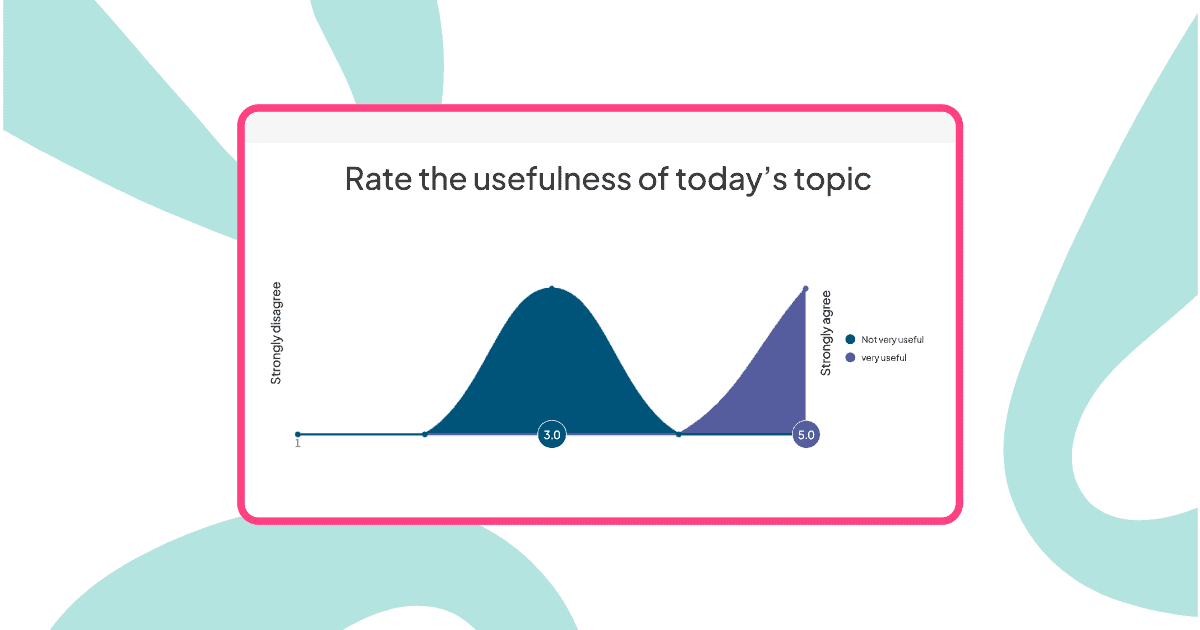Pernahkah Anda bertanya-tanya bagaimana perasaan karyawan Anda sebenarnya tentang peran, kontribusi, dan kepuasan kerja mereka secara keseluruhan?
Karier yang memuaskan tak lagi terbatas pada gaji di akhir bulan. Di era kerja jarak jauh, jam kerja fleksibel, dan peran kerja yang terus berkembang, definisi kepuasan kerja telah berubah drastis.
Masalahnya begini: survei tahunan tradisional seringkali menghasilkan tingkat respons yang rendah, wawasan yang tertunda, dan jawaban yang disunting. Karyawan mengisinya sendirian di meja mereka, tidak fokus pada momen tersebut, dan takut ketahuan. Saat Anda menganalisis hasilnya, masalahnya sudah meningkat atau terlupakan.
Ada cara yang lebih baik. Survei kepuasan kerja interaktif yang dilakukan selama rapat tim, rapat umum, atau sesi pelatihan menangkap umpan balik autentik saat itu juga—ketika keterlibatan paling tinggi dan Anda dapat mengatasi masalah secara real-time.
Dalam panduan ini, kami akan memberikan 46 contoh pertanyaan untuk kuesioner kepuasan kerja Anda, menunjukkan kepada Anda cara mengubah survei statis menjadi percakapan yang menarik, dan membantu Anda menumbuhkan budaya tempat kerja yang memelihara keterlibatan karyawan, memicu inovasi, dan menyiapkan panggung untuk kesuksesan yang langgeng.
Daftar Isi
- Apa itu Kuesioner Kepuasan Kerja?
- Mengapa Melakukan Kuesioner Kepuasan Kerja?
- Perbedaan Antara Survei Tradisional dan Interaktif
- 46 Contoh Pertanyaan untuk Kuesioner Kepuasan Kerja
- Cara Melakukan Survei Kepuasan Kerja yang Efektif dengan AhaSlides
- Mengapa Survei Interaktif Bekerja Lebih Baik Dibandingkan Formulir Tradisional
- Ringkasan Utama
Apa itu Kuesioner Kepuasan Kerja?
Kuesioner kepuasan kerja, juga dikenal sebagai survei kepuasan karyawan, adalah alat strategis yang digunakan oleh profesional SDM dan pemimpin organisasi untuk memahami seberapa puas karyawan mereka terhadap peran mereka.
Terdiri dari pertanyaan-pertanyaan yang disusun secara cermat yang dirancang untuk mencakup area-area penting termasuk lingkungan kerja, tanggung jawab pekerjaan, hubungan dengan kolega dan supervisor, kompensasi, peluang pertumbuhan, kesejahteraan, dan banyak lagi.
Pendekatan tradisional: Kirimkan tautan survei, tunggu respons berdatangan, analisis data beberapa minggu kemudian, lalu terapkan perubahan yang terasa tidak berhubungan dengan permasalahan awal.
Pendekatan interaktif: Ajukan pertanyaan secara langsung selama rapat, kumpulkan umpan balik langsung melalui jajak pendapat anonim dan awan kata, diskusikan hasil secara real-time, dan kembangkan solusi secara kolaboratif saat percakapan masih hangat.
Mengapa Melakukan Kuesioner Kepuasan Kerja?
penelitian Pew Menyoroti bahwa hampir 39% pekerja non-wiraswasta menganggap pekerjaan mereka krusial bagi identitas mereka secara keseluruhan. Sentimen ini dibentuk oleh faktor-faktor seperti pendapatan keluarga dan pendidikan, dengan 47% pekerja berpenghasilan tinggi dan 53% lulusan pascasarjana menganggap penting identitas pekerjaan mereka. Interaksi ini krusial bagi kepuasan karyawan, sehingga kuesioner kepuasan kerja yang terstruktur dengan baik penting untuk memelihara tujuan dan kesejahteraan.
Melakukan kuesioner kepuasan kerja menawarkan keuntungan besar bagi karyawan dan organisasi:
Pemahaman yang Berwawasan
Pertanyaan spesifik mengungkapkan perasaan karyawan yang sebenarnya, mengungkap pendapat, kekhawatiran, dan area kepuasan. Ketika dilakukan secara interaktif dengan pilihan jawaban anonim, Anda menghindari rasa takut akan identifikasi yang sering kali menyebabkan umpan balik tidak jujur dalam survei tradisional.
Identifikasi Masalah
Kueri yang tertarget mengidentifikasi titik-titik masalah yang memengaruhi moral dan keterlibatan—baik yang berkaitan dengan komunikasi, beban kerja, maupun peluang pertumbuhan. Awan kata real-time dapat langsung memvisualisasikan di mana sebagian besar karyawan sedang berjuang.
Solusi yang Disesuaikan
Wawasan yang dikumpulkan memungkinkan solusi yang disesuaikan, menunjukkan komitmen Anda untuk meningkatkan kondisi kerja. Ketika karyawan melihat umpan balik mereka langsung ditampilkan dan didiskusikan secara terbuka, mereka merasa benar-benar didengarkan, alih-alih hanya disurvei.
Peningkatan Keterlibatan dan Retensi
Menangani permasalahan berdasarkan hasil kuesioner meningkatkan keterlibatan, berkontribusi pada penurunan tingkat pergantian karyawan dan peningkatan loyalitas. Survei interaktif mengubah pengumpulan umpan balik dari proses birokrasi menjadi percakapan yang bermakna.
Perbedaan Antara Survei Tradisional dan Interaktif
| Aspek | Survei tradisional | Survei interaktif (AhaSlides) |
|---|---|---|
| Pemilihan waktu | Dikirim melalui email, diselesaikan sendiri | Dilakukan secara langsung selama rapat |
| Respon makan | rata-rata 30-40% | 85-95% saat disajikan secara langsung |
| keadaan tanpa nama | Dipertanyakan—karyawan khawatir tentang pelacakan | Anonimitas sejati tanpa perlu login |
| Keterlibatan | Terasa seperti pekerjaan rumah | Terasa seperti percakapan |
| Hasil | Beberapa hari atau minggu kemudian | Visualisasi instan dan waktu nyata |
| Tindakan | Tertunda, terputus | Diskusi dan solusi segera |
| dibentuk | Bentuk statis | Jajak pendapat dinamis, awan kata, Tanya Jawab, peringkat |
Wawasan utama: Orang lebih terlibat ketika umpan balik terasa seperti dialog daripada dokumentasi.
46 Contoh Pertanyaan untuk Kuesioner Kepuasan Kerja
Berikut contoh pertanyaan yang disusun berdasarkan kategori. Setiap bagian berisi panduan tentang cara menyajikannya secara interaktif untuk kejujuran dan keterlibatan maksimal.
Lingkungan kerja
pertanyaan:
- Bagaimana Anda menilai kenyamanan fisik dan keamanan ruang kerja Anda?
- Apakah Anda puas dengan kebersihan dan keteraturan tempat kerja?
- Apakah menurut Anda suasana kantor mendorong budaya kerja yang positif?
- Apakah Anda dilengkapi dengan alat dan sumber daya yang diperlukan untuk melakukan pekerjaan Anda secara efektif?
Pendekatan interaktif dengan AhaSlides:
- Gunakan skala penilaian (1-5 bintang) yang ditampilkan secara langsung
- Lanjutkan dengan awan kata terbuka: "Dalam satu kata, jelaskan suasana tempat kerja kita"
- Aktifkan mode anonim sehingga karyawan menilai kondisi fisik secara jujur tanpa rasa takut
- Tampilkan hasil agregat segera untuk memulai diskusi
Mengapa ini berhasil: Ketika karyawan melihat orang lain berbagi kekhawatiran serupa (misalnya, banyak orang menilai "alat dan sumber daya" sebagai 2/5), mereka merasa divalidasi dan lebih bersedia untuk menguraikan lebih lanjut dalam sesi tanya jawab lanjutan.
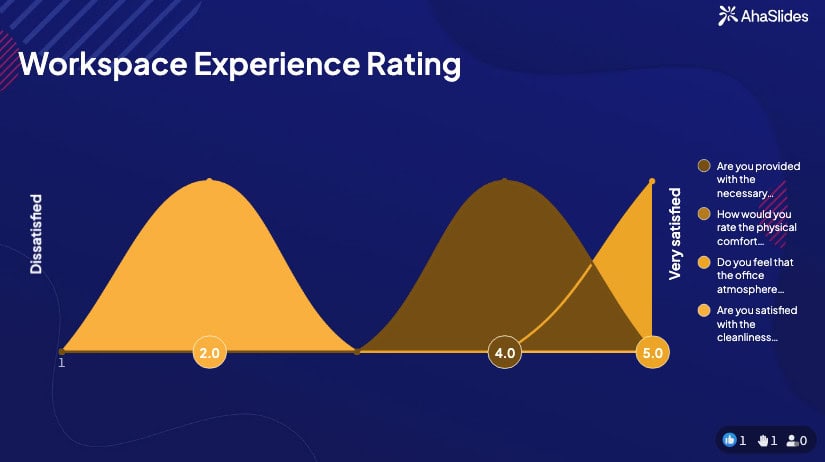
Coba templat jajak pendapat lingkungan tempat kerja →
Tanggung jawab pekerjaan
pertanyaan:
- Apakah tanggung jawab pekerjaan Anda saat ini selaras dengan keterampilan dan kualifikasi Anda?
- Apakah tugas Anda didefinisikan dengan jelas dan dikomunikasikan kepada Anda?
- Apakah Anda memiliki peluang untuk menghadapi tantangan baru dan mengembangkan keterampilan Anda?
- Apakah Anda puas dengan keragaman dan kompleksitas tugas sehari-hari Anda?
- Apakah Anda merasa pekerjaan Anda memberi tujuan dan kepuasan?
- Apakah Anda puas dengan tingkat otoritas pengambilan keputusan yang Anda miliki dalam peran Anda?
- Apakah Anda yakin tanggung jawab pekerjaan Anda selaras dengan tujuan dan misi organisasi secara keseluruhan?
- Apakah Anda diberikan pedoman dan harapan yang jelas untuk tugas dan proyek pekerjaan Anda?
- Seberapa baik Anda merasa tanggung jawab pekerjaan Anda berkontribusi terhadap kesuksesan dan pertumbuhan perusahaan?
Pendekatan interaktif dengan AhaSlides:
- Sajikan jajak pendapat ya/tidak untuk pertanyaan yang jelas (misalnya, "Apakah tugas Anda didefinisikan dengan jelas?")
- Gunakan skala penilaian untuk tingkat kepuasan
- Dilanjutkan dengan tanya jawab terbuka: "Tanggung jawab apa yang ingin Anda tambahkan atau hapus?"
- Buatlah awan kata: "Jelaskan peran Anda dalam tiga kata"
Pro tip: Fitur Tanya Jawab anonim sangat bermanfaat di sini. Karyawan dapat mengajukan pertanyaan seperti "Mengapa kita tidak memiliki lebih banyak otonomi dalam pengambilan keputusan?" tanpa takut identitasnya teridentifikasi, sehingga manajer dapat membahas masalah sistemik secara terbuka.
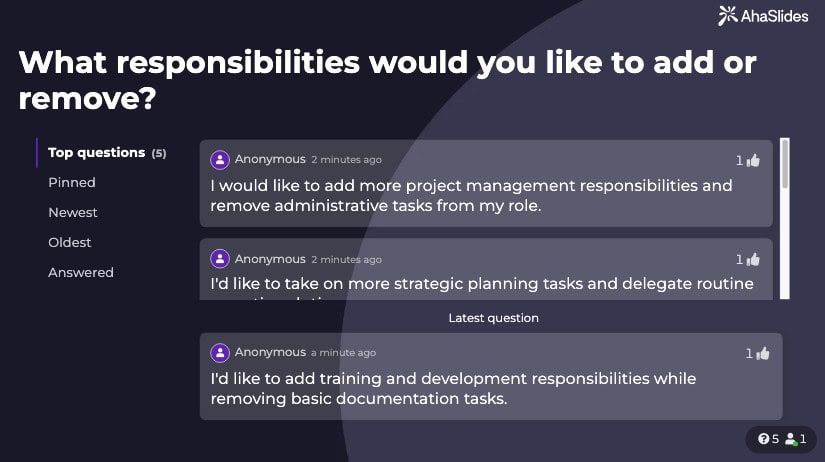
Pengawasan dan Kepemimpinan
pertanyaan:
- Bagaimana Anda menilai kualitas komunikasi antara Anda dan atasan Anda?
- Apakah Anda menerima umpan balik dan bimbingan yang membangun mengenai kinerja Anda?
- Apakah Anda terdorong untuk menyuarakan pendapat dan saran Anda kepada atasan Anda?
- Apakah Anda merasa bahwa atasan Anda menghargai kontribusi Anda dan mengakui usaha Anda?
- Apakah Anda puas dengan gaya kepemimpinan dan pendekatan manajemen di departemen Anda?
- Menurut Anda, jenis keterampilan kepemimpinan apa yang paling efektif dalam tim Anda?
Pendekatan interaktif dengan AhaSlides:
- Gunakan skala penilaian anonim untuk umpan balik supervisor yang sensitif
- Hadirkan pilihan gaya kepemimpinan (demokratis, pembinaan, transformasional, dll.) dan tanyakan karyawan mana yang lebih suka
- Aktifkan Tanya Jawab langsung di mana karyawan dapat mengajukan pertanyaan tentang pendekatan manajemen
- Buat peringkat: "Apa yang paling penting bagi Anda dari seorang supervisor?" (Komunikasi, Pengakuan, Umpan Balik, Otonomi, Dukungan)
Mengapa anonimitas penting: Menurut lembar kerja pemosisian Anda, profesional SDM perlu "menciptakan ruang aman untuk diskusi yang jujur". Jajak pendapat anonim interaktif selama rapat umum memungkinkan karyawan menilai kepemimpinan secara jujur tanpa mempertimbangkan karier—sesuatu yang sulit dicapai secara meyakinkan oleh survei tradisional.
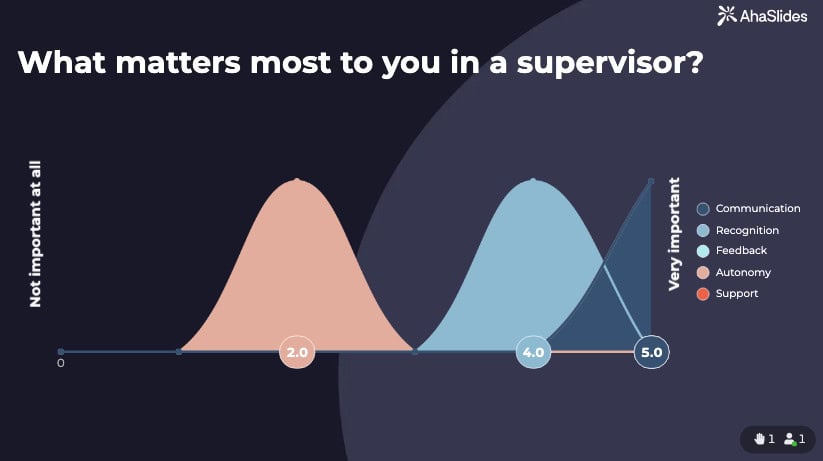
Pertumbuhan dan Perkembangan Karir
pertanyaan:
- Apakah Anda diberi peluang untuk pertumbuhan dan kemajuan profesional?
- Seberapa puaskah Anda dengan program pelatihan dan pengembangan yang ditawarkan oleh organisasi?
- Apakah Anda yakin bahwa peran Anda saat ini selaras dengan tujuan karier jangka panjang Anda?
- Apakah Anda diberi kesempatan untuk mengambil peran kepemimpinan atau proyek khusus?
- Apakah Anda menerima dukungan untuk melanjutkan pendidikan lebih lanjut atau peningkatan keterampilan?
Pendekatan interaktif dengan AhaSlides:
- Jajak pendapat: "Jenis pengembangan profesional apa yang paling bermanfaat bagi Anda?" (Pelatihan kepemimpinan, Keterampilan teknis, Sertifikasi, Mentoring, Pindahan lateral)
- Awan kata: "Di mana Anda melihat diri Anda dalam 3 tahun?"
- Skala penilaian: "Seberapa besar dukungan yang Anda rasakan dalam pengembangan karier Anda?" (1-10)
- Tanya Jawab terbuka bagi karyawan untuk menanyakan tentang peluang pengembangan tertentu
Keuntungan strategis: Berbeda dengan survei tradisional yang datanya tersimpan dalam lembar kerja, penyajian pertanyaan pengembangan karier secara langsung selama tinjauan triwulan memungkinkan SDM untuk segera membahas anggaran pelatihan, program bimbingan, dan peluang mobilitas internal saat percakapan sedang berlangsung.
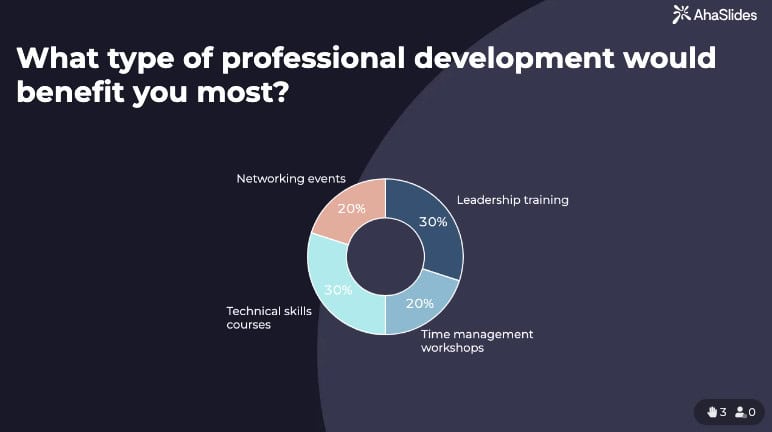
Kompensasi dan keuntungan
pertanyaan:
- Apakah Anda puas dengan gaji dan paket kompensasi Anda saat ini, termasuk tunjangan?
- Apakah Anda merasa bahwa kontribusi dan pencapaian Anda diberi penghargaan yang pantas?
- Apakah manfaat yang ditawarkan organisasi komprehensif dan sesuai dengan kebutuhan Anda?
- Bagaimana Anda menilai transparansi dan keadilan dalam proses evaluasi kinerja dan kompensasi?
- Apakah Anda puas dengan peluang mendapatkan bonus, insentif, atau imbalan?
- Apakah Anda puas dengan kebijakan cuti tahunan?
Pendekatan interaktif dengan AhaSlides:
- Jajak pendapat anonim ya/tidak untuk pertanyaan gaji yang sensitif
- Pilihan ganda: "Manfaat apa yang paling penting bagi Anda?" (Kesehatan, Fleksibilitas, Anggaran pendidikan, Program kesehatan, Pensiun)
- Skala penilaian: "Seberapa adil kompensasi kami dibandingkan dengan kontribusi Anda?"
- Awan kata: "Manfaat apa yang paling meningkatkan kepuasan Anda?"
Catatan kritis: Di sinilah survei interaktif anonim benar-benar unggul. Karyawan jarang memberikan umpan balik kompensasi yang jujur dalam survei tradisional yang memerlukan kredensial masuk. Polling anonim langsung selama rapat umum, di mana tanggapan muncul tanpa nama, menciptakan rasa aman secara psikologis untuk umpan balik yang tulus.
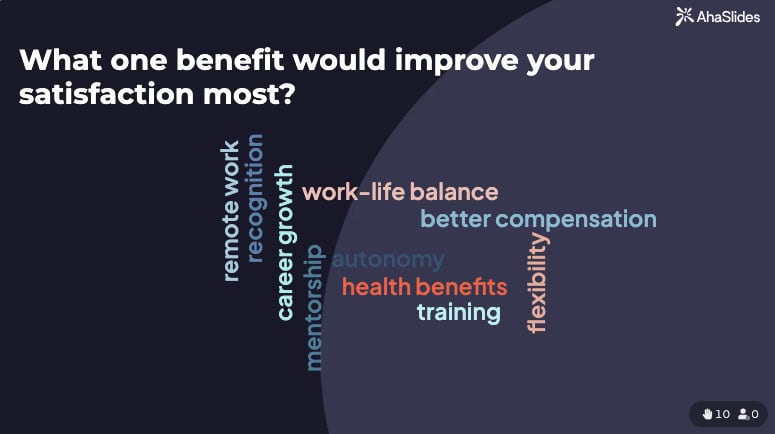
Buat sesi umpan balik kompensasi Anda →
Hubungan dan Kolaborasi
pertanyaan:
- Seberapa baik Anda berkolaborasi dan berkomunikasi dengan kolega Anda?
- Apakah Anda merasakan rasa persahabatan dan kerja tim dalam departemen Anda?
- Apakah Anda puas dengan tingkat rasa hormat dan kerja sama di antara rekan-rekan Anda?
- Apakah Anda memiliki kesempatan untuk berinteraksi dengan kolega dari departemen atau tim berbeda?
- Apakah Anda merasa nyaman mencari bantuan atau saran dari kolega Anda saat dibutuhkan?
Pendekatan interaktif dengan AhaSlides:
- Skala penilaian untuk kualitas kolaborasi
- Awan kata: "Jelaskan budaya tim kami dalam satu kata"
- Pilihan ganda: "Seberapa sering Anda berkolaborasi lintas departemen?" (Harian, Mingguan, Bulanan, Jarang, Tidak Pernah)
- Tanya Jawab Anonim untuk mengungkap masalah interpersonal
Kesejahteraan dan Keseimbangan Kehidupan dan Pekerjaan
pertanyaan:
- Seberapa puaskah Anda dengan keseimbangan kehidupan kerja yang disediakan oleh organisasi?
- Apakah Anda merasa mendapat dukungan yang cukup dari perusahaan dalam mengelola stres dan menjaga kesehatan mental Anda?
- Apakah Anda merasa nyaman mencari bantuan atau sumber daya untuk mengatasi tantangan pribadi atau terkait pekerjaan?
- Seberapa sering Anda terlibat dalam program atau kegiatan kesehatan yang disediakan oleh organisasi?
- Apakah Anda percaya bahwa perusahaan menghargai dan memprioritaskan kesejahteraan karyawannya?
- Apakah Anda puas dengan lingkungan kerja fisik dalam hal kenyamanan, pencahayaan, dan ergonomis?
- Seberapa baik organisasi mengakomodasi kebutuhan kesehatan dan kesejahteraan Anda (misalnya, jam kerja fleksibel, opsi kerja jarak jauh)?
- Apakah Anda merasa terdorong untuk beristirahat dan memutuskan hubungan kerja saat diperlukan untuk memulihkan tenaga?
- Seberapa sering Anda merasa kewalahan atau stres karena faktor terkait pekerjaan?
- Apakah Anda puas dengan manfaat kesehatan dan kesejahteraan yang ditawarkan oleh organisasi?
Pendekatan interaktif dengan AhaSlides:
- Skala frekuensi: "Seberapa sering Anda merasa stres?" (Tidak pernah, Jarang, Kadang-kadang, Sering, Selalu)
- Jajak pendapat ya/tidak mengenai dukungan kesejahteraan
- Slider anonim: "Beri peringkat tingkat kelelahan Anda saat ini" (1-10)
- Awan kata: "Apa yang paling dapat meningkatkan kesejahteraan Anda?"
- Tanya Jawab terbuka bagi karyawan untuk berbagi masalah kesejahteraan secara anonim
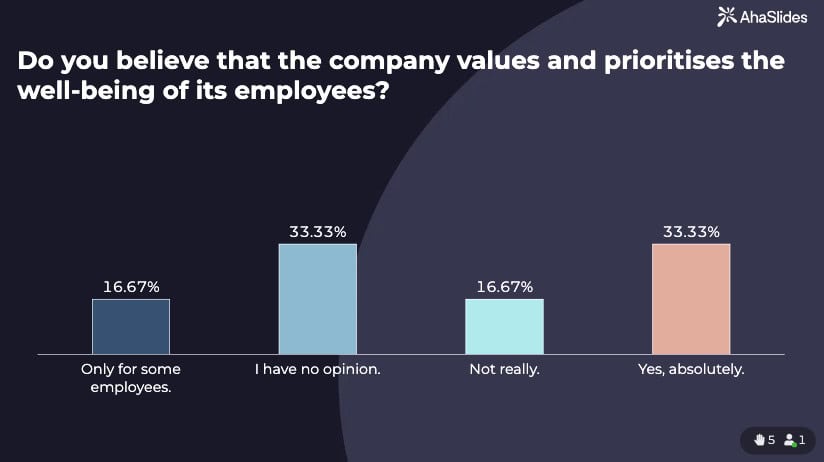
Mengapa ini penting: Lembar kerja pemosisian Anda mengidentifikasi bahwa profesional SDM kesulitan dengan "keterlibatan dan umpan balik karyawan" serta "menciptakan ruang aman untuk diskusi yang jujur". Pertanyaan tentang kesejahteraan pada dasarnya sensitif—karyawan takut terlihat lemah atau tidak berkomitmen jika mereka mengaku mengalami kelelahan. Survei anonim interaktif menghilangkan hambatan ini.
Kepuasan Keseluruhan
Pertanyaan terakhir: 46. Dalam skala 1-10, seberapa besar kemungkinan Anda merekomendasikan perusahaan ini sebagai tempat kerja yang baik? (Skor Net Promoter Karyawan)
Pendekatan interaktif:
- Tindak lanjut berdasarkan hasil: Jika skornya rendah, segera tanyakan "Apa satu hal yang dapat kami ubah untuk meningkatkan skor Anda?"
- Menampilkan eNPS secara real-time sehingga pimpinan dapat melihat sentimen secara langsung
- Gunakan hasil untuk mendorong percakapan transparan tentang peningkatan organisasi
Cara Melakukan Survei Kepuasan Kerja yang Efektif dengan AhaSlides
Langkah 1: Pilih Format Anda
Opsi A: Langsung selama rapat seluruh karyawan
- Ajukan 8-12 pertanyaan kunci selama pertemuan kota triwulanan
- Gunakan mode anonim untuk topik sensitif
- Diskusikan hasil segera dengan kelompok
- Terbaik untuk: Membangun kepercayaan, tindakan segera, pemecahan masalah secara kolaboratif
Pilihan B: Belajar dengan kecepatan sendiri namun interaktif
- Bagikan tautan presentasi yang dapat diakses karyawan kapan saja
- Sertakan semua 46 pertanyaan yang disusun berdasarkan kategori
- Tetapkan tenggat waktu untuk penyelesaian
- Terbaik untuk: Pengumpulan data yang komprehensif, waktu yang fleksibel
Opsi C: Pendekatan hibrida (disarankan)
- Kirimkan 5-7 pertanyaan kritis sebagai jajak pendapat mandiri
- Hasil saat ini dan 3 perhatian utama akan disampaikan pada rapat tim berikutnya
- Gunakan Tanya Jawab langsung untuk mendalami masalah lebih dalam
- Terbaik untuk: Partisipasi maksimal dengan diskusi yang bermakna
Langkah 2: Siapkan Survei Anda di AhaSlides
Fitur yang dapat digunakan:
- Skala penilaian untuk tingkat kepuasan
- Jajak pendapat pilihan ganda untuk pertanyaan preferensi
- Awan kata untuk memvisualisasikan tema umum
- Tanya Jawab Terbuka bagi karyawan untuk mengajukan pertanyaan anonim
- Modus anonim untuk memastikan keamanan psikologis
- Tampilan hasil langsung untuk menunjukkan transparansi
Tips menghemat waktu: Gunakan generator AI AhaSlides untuk membuat survei dengan cepat dari daftar pertanyaan ini, lalu sesuaikan dengan kebutuhan spesifik organisasi Anda.
Langkah 3: Komunikasikan Tujuannya
Sebelum meluncurkan survei Anda, jelaskan:
- Mengapa Anda melakukannya (bukan hanya "karena sudah waktunya untuk survei tahunan")
- Bagaimana tanggapan akan digunakan
- Bahwa tanggapan anonim benar-benar anonim
- Kapan dan bagaimana Anda akan membagikan hasil dan mengambil tindakan
Naskah membangun kepercayaan: Kami ingin memahami perasaan Anda yang sebenarnya tentang bekerja di sini. Kami menggunakan jajak pendapat interaktif anonim karena kami tahu survei tradisional tidak dapat menangkap umpan balik jujur Anda. Respons Anda akan muncul tanpa nama, dan kami akan membahas hasilnya bersama-sama untuk mengembangkan solusi secara kolaboratif.
Langkah 4: Presentasikan Secara Langsung (Jika Ada)
Struktur pertemuan:
- Pendahuluan (2 menit): Jelaskan tujuan dan anonimitas
- Pertanyaan survei (15-20 menit): Menampilkan jajak pendapat satu per satu, menunjukkan hasil langsung
- Diskusi (15-20 menit): Segera atasi masalah utama
- Perencanaan tindakan (10 menit): Berkomitmen pada langkah selanjutnya yang spesifik
- Tanya Jawab lanjutan (10 menit): Lantai terbuka untuk pertanyaan anonim
Pro tip: Ketika hasil yang sensitif muncul (misalnya, 70% responden menilai komunikasi kepemimpinan buruk), segera akui: "Ini umpan balik yang penting. Mari kita bahas apa arti 'komunikasi yang buruk' bagi Anda. Gunakan sesi Tanya Jawab untuk membagikan contoh spesifik secara anonim."
Langkah 5: Bertindak Berdasarkan Hasil
Di sinilah survei interaktif menciptakan keunggulan kompetitif. Karena Anda telah mengumpulkan umpan balik selama percakapan langsung:
- Karyawan sudah melihat hasilnya
- Anda telah berkomitmen untuk melakukan tindakan secara publik
- Tindak lanjut diharapkan dan terlihat
- Kepercayaan terbentuk ketika janji ditepati
Templat rencana tindakan:
- Bagikan hasil terperinci dalam waktu 48 jam
- Identifikasi 3 area utama yang perlu ditingkatkan
- Membentuk kelompok kerja untuk mengembangkan solusi
- Komunikasikan kemajuan setiap bulan
- Survei ulang dalam 6 bulan untuk mengukur peningkatan
Mengapa Survei Interaktif Bekerja Lebih Baik Dibandingkan Formulir Tradisional
Berdasarkan kebutuhan organisasi Anda, Anda perlu:
- "Mengukur keterlibatan karyawan selama inisiatif SDM"
- "Memfasilitasi sesi tanya jawab anonim di balai kota"
- "Kumpulkan sentimen karyawan menggunakan awan kata dan jajak pendapat langsung"
- “Ciptakan ruang aman untuk diskusi yang jujur”
Alat survei tradisional seperti Google Forms atau SurveyMonkey tidak dapat memberikan pengalaman ini. Alat-alat tersebut mengumpulkan data, tetapi tidak menciptakan dialog. Alat-alat tersebut mengumpulkan respons, tetapi tidak membangun kepercayaan.
Platform interaktif seperti AhaSlides mengubah pengumpulan umpan balik dari latihan birokrasi menjadi percakapan yang bermakna di mana:
- Karyawan melihat suara mereka penting secara real-time
- Para pemimpin menunjukkan komitmen langsung untuk mendengarkan
- Anonimitas menghilangkan rasa takut sementara transparansi membangun kepercayaan
- Diskusi menghasilkan solusi kolaboratif
- Data menjadi pembuka percakapan, bukan laporan yang tersimpan di laci
Ringkasan Utama
✅ Survei kepuasan kerja adalah alat strategis, bukan kotak centang administratif. Mereka mengungkapkan apa yang mendorong keterlibatan, retensi, dan kinerja.
✅ Survei interaktif menghasilkan hasil yang lebih baik daripada bentuk tradisional—tingkat respons yang lebih tinggi, umpan balik yang lebih jujur, dan peluang diskusi langsung.
✅ Anonimitas plus transparansi Menciptakan rasa aman psikologis yang dibutuhkan untuk umpan balik yang tulus. Karyawan menjawab dengan jujur ketika mereka tahu tanggapannya anonim, tetapi melihat bahwa para pemimpin mengambil tindakan.
✅ 46 pertanyaan dalam panduan ini mencakup dimensi kritis kepuasan kerja: lingkungan, tanggung jawab, kepemimpinan, pertumbuhan, kompensasi, hubungan, dan kesejahteraan.
✅ Hasil waktu nyata memungkinkan tindakan segera. Ketika karyawan melihat masukan mereka divisualisasikan secara instan dan didiskusikan secara terbuka, mereka merasa didengarkan, bukan sekadar disurvei.
✅ Peralatan itu penting. Platform seperti AhaSlides dengan jajak pendapat langsung, awan kata, Tanya Jawab anonim, dan tampilan hasil waktu nyata mengubah kuesioner statis menjadi percakapan dinamis yang mendorong perubahan organisasi.
Referensi:




